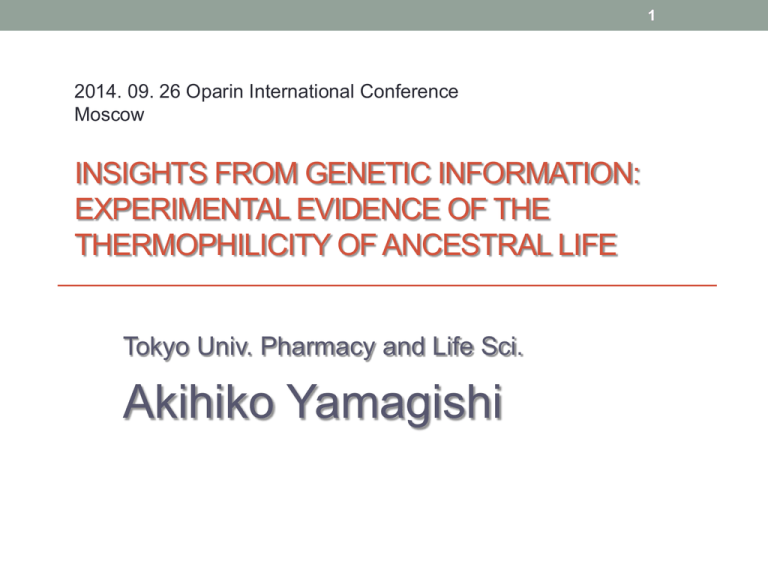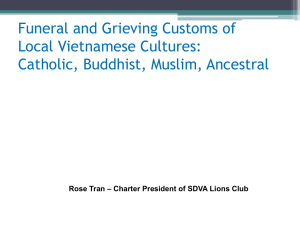R - international conference «the problem of the origin of life
advertisement

1 2014. 09. 26 Oparin International Conference Moscow INSIGHTS FROM GENETIC INFORMATION: EXPERIMENTAL EVIDENCE OF THE THERMOPHILICITY OF ANCESTRAL LIFE Tokyo Univ. Pharmacy and Life Sci. Akihiko Yamagishi 2 Origin of Life: Emergence and early development of life. Oparin Japanese translation published in 1969 3 Content 1. Phylogenetic analysis 2.Ancestral mutants 3.Ancestral enzyme 1. Phylogenetic analysis The way of analysing the history of life Amino acid sequences of the gene of hemoglobin human horse carp VLSPADKTNVKAAWGKVGAHAGEYGAEALERMFLAFPTTKTYFPHF VLSAADKTNVKAAWSKVGGHAGEYGAEALERMFLGFPTTKTYFPHF SLSDKSKAAVKIAWAKISPKADDIGAEALGRMLTVYPQTKTYFAHW By comparing the sequence of genes, you can infer the phylogenetic tree. human horse carp 1. Phylogenetic analysis Phylogenetic tree of all the organisms chloroplasts 45 Euryarchaeota Crenarchaeota Gram-positive bacteria 65 cyanobacteria 65 Thermus75 green non-sulfur bacteria 60 Thermotoga 80 Apuifex 85 Sulfolobus 80 Pyrodictium 105 Thermoproteus88 Thermococcus88 Methanococcus88 Methanobacterium70 Thermoplasma 60 extreme halophiles 55 Methanosarcina 40 Methanospirillum37 P microsporidia P' The last common ancestor (Commonote or LUCA) Origin of life Woese et al. 1990 mitochondria 55 flagellates animals plants fungi 55 Bacteria Archaea Eucarya (Eubacteria)(Archaebacteria) (Eukaryotes) purple bacteria 60 1. Phylogenetic analysis Divergence times (Ga) among major groups. (Feng et al. 1997, Hodges & Kumar “Timetree of Life” 2009)) Groups Divergence times (Ga) Archaea/Bacteria 3.8 (3.3-4.2) Archaea/Eucarya 3.8 (2.4-3.8) Bacteria/Eucarya 2.0 (1.8-2.5) Metazoa/Plantae 1.59 Metazoa/Fungi 1.37 Choanoflagellida/Metazoa 1.02 Deuterostomia/Protostomia 0.91 Echinodermata/Chordata 0.84 1. Phylogenetic analysis 7 General phylogenetic tree with optimum growth temperature 3.8 Ga mitochondria 55 chloroplasts 45 Euryarchaeota Crenarchaeota P microsporidia P' The last common ancestor (Commonote or LUCA) Origin of life Gram-positive bacteria 65 cyanobacteria 65 Thermus75 green non-sulfur bacteria 60 Thermotoga 80 Apuifex 85 Sulfolobus 80 Pyrodictium 105 Thermoproteus88 Thermococcus88 Methanococcus88 Methanobacterium70 Thermoplasma 60 extreme halophiles 55 Methanosarcina 40 Methanospirillum37 flagellates animals plants fungi 55 Eucarya Archaea Bacteria (Eubacteria)(Archaebacteria) (Eukaryotes) 4 Ga purple bacteria 60 1. Phylogenetic analysis 8 Thermophilic and hyperthermophilic universal common ancestor hypothesis Woese, C. R. (1987) suggested that thermophilisity is ancestral characteristics of prokaryotes. Stetter, K.O., and Pace, N. R. (1991) proposed the hyperthermophilic universal common ancestor. Nisbet, E. G. and Fowler, C. M. R. (1996) suggested the hot origin of life from geological point of view. 1. Phylogenetic analysis 9 Arguments against the hyperthermophilic common ancestor hypothesis. ・Miller, S. L. & Lazcano, A. (1995) analyzed the stability of biological compound, suggesting that origin of life can not be hot. ・Forterre, P. (1996) criticized the interpretation of the phylogenetic tree: hyperthermophiles could be selected after branching into several species, thus the common ancestor may be mesophilic. ・Galtier, N., Taurasse, N. & Gouy, M. (1999) estimated GC-content of rRNA gene of the universal common ancestor. The GC content, which is correlated with growth temperature, was too low to be a hyperthermophile. 1. Phylogenetic analysis G+C content of rRNA is related to growth temperature . N. Galtier and J. R. Lobry (1997) The G+C nucleotide content of ribosomal RNA (rRNA) sequences is strongly correlated with the optimal growth temperature (OGT) of prokaryotes. N. Galtier, N. Tourasse, M. Gouy (1999) The inferred G+C content of small sub-unit rRNA and large sub-unit rRNA of the common ancestor to extant life forms appeared incompatible with survival at high temperature. 10 1. Phylogenetic analysis 11 Content of amino acid species (IVYWREL) K. Zeldovich et. al. (2007) IVYWREL content in proteome The total concentration of seven amino acids in proteomes (IVYWREL) serves as a universal proteomic predictor of OGT in prokaryotes, and the correlation coefficient is as high as 0.93. Optimum growth temperature (oC) 1. Phylogenetic analysis 12 Estimation of common ancestor from amino acid content. M. Groussin and M Gouy (2011) Non-(hyper)thermophilic common ancestor (20 ºC) 48 ºC difference Thermophilic common ancestor (68 ºC) B. Boussau et al (2008) 13 Content 1. Phylogenetic analysis 2.Ancestral mutants 3.Ancestral enzyme 2.Ancestral mutants Experimental test of the hypothesis, using an enzyme. (1)Construction of multiple sequence alignment and a phylogenetic tree. (2) Inference of ancestral amino acid. (3) Construction of ancestral mutants. (4) Expression and purification of ancestral mutants (5) Analysis of the thermo-stability 2.Ancestral mutants 15 Phylogenetic tree of twin enzymes, IPMDHs and ICDHs IC2 Saccharomyces cerevisiae IC1 Saccharomyces cerevisiae IC1 Arabidopsis thaliana Thermus thermophilus Caldococcus noboribetus Sulfolobus tokodaii Escherichia coli Thermus aquaticus Bacillus subtilis Archaea ICDH ICDH Bacteria Sulfolobus tokodaii Pyrococcus abyssi2 Archaea Thermus thermophilus Bacillus subtilis Saccharomyces cerevisiae Escherichia coli Thermotoga maritima Arabidopsis thaliana Aquifex aeolicus 0.1 IPMDH IPMDH Bacteria IPMDH: 3-isopropylmalate dehydrogenase, in leucine biosynthesis. ICDH: isocitrate dehydrogenase in glutamate biosynthesis. 2.Ancestral mutants 16 Multiple alignment of IPMDHs and ICDHs IB.sub IE.col IA.tum IS.cer IN.cra IT.the ISul#7 CB.tau CS.cer CB.sub CE.col Ancest 85 97 149 158 253 285 .IRKQLDLFANLRP...RVIREGFKMA...FEPVHGSAPDIAGKGMANPFAAILSAAMLLRTS.. .LRKHFKLFSNLRP...RIARIAFESA...YEPAGGSAPDIAGKNIANPIAQILSLALLLRYS.. .LRKDLELFANLRP...RIASVAFELA...YEPVHGSAPDIAGKSIANPIAMIASFAMCLRYS.. .IRKELQLYANLRP...RITRMAAFMA...YEPCHGSAPDL-PKNKVNPIATILSAAMMLKLS.. .LRKELGTYGNLRP...RIARLAGFLA...YEPIHGSAPDISGKGIVNPVGTILSVAMMLRYS.. .LRKSQDLFANLRP...RVARVAFEAA...FEPVHGSAPDIAGKGIANPTAAILSAAMMLEHA.. .LRQIYDMYANIRP...RIAKVGLNFA...FEPVHGAAFDIAGKNIGNPTAFLLSVSMMYERM.. .LRKTFDLYANVRP...RIAEFAFEYA...FESVHGTAPDIAGKDMANPTALLLSAVMMLRHM.. .LRKTFGLFANVRP...RVIRYAFEYA...FEAVHGSAPDIAGQDKANPTALLLSSVMMLNHM.. .LRQELDLFVCLRP...RLVRAAIDYA...FEATHGTAPKYAGLDKVNPSSVILSGVLLLEHL.. .LRQELDLYICLRP...RLVRAAIEYA...FEATHGTAPKYAGQDKVNPGSIILSAEMMLRHM.. # # # # ** * ** * .LRxxxDLxANLRP...RIARxAFExA...FExVHGSAPDIAGKxxxNPTAxxLSxxMMLxxx.. M91L K152R A259S Y282L I95L G154A F261P Ancest: The ancestral sequence inferred. 2.Ancestral mutants The way of inferring the ancestral amino acid residues which are possessed by the common ancestor by parsimony. R R R/K R R S R/S R R R R R IPMDH K Sulfolobus tokodaii R E/R R E R R R R R R ICDH 2.Ancestral mutants Multiple alignment of IPMDHs and ICDHs IB.sub IE.col IA.tum IS.cer IN.cra IT.the ISul#7 CB.tau CS.cer CB.sub CE.col Ancest 85 97 149 158 253 285 .IRKQLDLFANLRP...RVIREGFKMA...FEPVHGSAPDIAGKGMANPFAAILSAAMLLRTS.. .LRKHFKLFSNLRP...RIARIAFESA...YEPAGGSAPDIAGKNIANPIAQILSLALLLRYS.. .LRKDLELFANLRP...RIASVAFELA...YEPVHGSAPDIAGKSIANPIAMIASFAMCLRYS.. .IRKELQLYANLRP...RITRMAAFMA...YEPCHGSAPDL-PKNKVNPIATILSAAMMLKLS.. .LRKELGTYGNLRP...RIARLAGFLA...YEPIHGSAPDISGKGIVNPVGTILSVAMMLRYS.. .LRKSQDLFANLRP...RVARVAFEAA...FEPVHGSAPDIAGKGIANPTAAILSAAMMLEHA.. .LRQIYDMYANIRP...RIAKVGLNFA...FEPVHGAAFDIAGKNIGNPTAFLLSVSMMYERM.. .LRKTFDLYANVRP...RIAEFAFEYA...FESVHGTAPDIAGKDMANPTALLLSAVMMLRHM.. .LRKTFGLFANVRP...RVIRYAFEYA...FEAVHGSAPDIAGQDKANPTALLLSSVMMLNHM.. .LRQELDLFVCLRP...RLVRAAIDYA...FEATHGTAPKYAGLDKVNPSSVILSGVLLLEHL.. .LRQELDLYICLRP...RLVRAAIEYA...FEATHGTAPKYAGQDKVNPGSIILSAEMMLRHM.. # # # # ** * ** * .LRxxxDLxANLRP...RIARxAFExA...FExVHGSAPDIAGKxxxNPTAxxLSxxMMLxxx.. M91L K152R A259S Y282L I95L G154A F261P - Ancest: The ancestral sequence inferred. - Isul#7: IPMDH of an hyper-thermophile, Sulfolobus tokodaii. Most of the residues are conserved and are shown in yellow. Some are not, and are shown in green. - Ancest residues shown in pink, were introduced as mutation, starting from contemporary hyperthermophile enzyme Isul#7. 2.Ancestral mutants 19 Denaturation curve of the wild type and ancestral mutants of S.tokodaii IPMDH estimated by CD at 222nm. 5/7 mutants showed higher thermal stability than the wild type. Miyazaki et al. J. Biochem (2001). 129, 777-782 2.Ancestral mutants 20 We inferred the ancestral sequence and analyzed the enzymes. 1. Sulfolobus tokodaii IPMDH :Hyperthermophilic archaeon 5/7 ancestral mutants showed higher thermostability than the wild-type IPMDH. 2. Caldococcus noboribetus ICDH: Hyperthermophilic archaeon 4/5 ancestral mutants showed higher thermostability than the wild-type ICDH. 3. Thermus thermophilus IPMDH:Thermophilic bacteria 6/12 ancestral mutants showed higher thermostability than the wild-type IPMDH. 4. Thermus thermophilus Gly-RS:Thermophilic bacteria 6/8 ancestral mutants showed higher thermostability than the wild-type Gly-RS. 2.Ancestral mutants 21 Lesson 1. 1. The last common ancestor was a hyper-themophile. 22 Content 1. Phylogenetic analysis 2.Ancestral mutants 3.Ancestral enzyme 3.Ancestral enzyme 23 4. ANCESTRAL ENZYME Total synthesis of ancestral genes. S. Akanuma, Y.Nakajima, S.Yokobori, M. Kimura, N. Nemoto, T. Mase, K.Miyazono, M. Tanokura, A. Yamagishi (2013) Proc. Natl. Acad. Scie. USA. 110, 11067-11072 3.Ancestral enzyme 24 Bacterial ancestor. We decided to make archaeal ancestor as well as bacterial ancestore. E.A. Gaucher et al. (2003, 2008) The thermostabilities of resurrected ancient bacterial EF-Tu suggest that the bacterial common ancestor (BCA) was thermophilic organism but not hyperthermophilic one. The phylogenetic tree of bacterial EF-Tu and melting temperatures for ancient EF proteins BCA This protein’s host organism was thermophilic 3.Ancestral enzyme 25 NDK is an enzyme involved in nucleotide synthesis. Material Nucleoside diphosphate kinase (NDK) N PPP NDK P N PP N: nucleoside P: phosphate NDK PP N NDK PPP N 3.Ancestral enzyme Unfolding midpoint temperature (oC) Relation between growth temperature and stability of protein 120 P. horikoshii S. tokodaii 100 T. thermophilus 80 A. pernix M. jannaschii A. fulgidus M. thermautotrophicus D. discoideum B. subtilis 60 E. coli 20 40 40 60 80 100 Optimal Growth Temperature (oC) 3.Ancestral enzyme Whole-gene synthesis of ancestral sequence. (1)Construction of multiple sequence alignment and a phylogenetic tree. (2) Inference of ancestral amino acid. (3) Whole-gene synthesis of ancestral sequence. (4) Expression and purification of ancestral protain (5) Analysis of the thermo-stability 28 3.Ancestral enzyme Programs used for the phylogenetic analysis Archaeal ancestor Bacterial ancestor Name of Program used reconstructed protein CODEML in PAML Arc1 nhPhyloBayes Arc2 CODEML in PAML Bac1 nhPhyloBayes Bac2 Whole-gene synthesis using synthetic DNA and PCR. Express the gene in E. coli and purify the enzymes. 3.Ancestral enzyme 29 NDKs of Archaeal (Red) and Bacterial (Blue) ancestors. Arc3 NDK ML tree NDK ML tree (non-constrained) (constrained) Arc4 Bac3 Arc5 Bac5 Bac4 16S rRNA ML tree 3.Ancestral enzyme 30 The sequences of ancestral NDKs were synthesized and introduced into E. coli and the proteins were produced in E. coli cells and purifed. 3.Ancestral enzyme 31 Thermal stabilities of ancestral NDKs: Tm ( oC) Archaeal Bacterial pH 6.0 pH 7.6 pH 6.0 pH 7.6 Afu NDK 100 n.d. Tth NDK 99 99 Arc1 114 113 Bac1 99 101 Arc2 109 109 Bac2 98 101 Arc3 112 111 Bac3 109 109 Arc3sec 109 n.a. Bac3sec 108 n.a. Arc4 109 110 Bac4 102 99 99 n.a. Bac4sec 98 n.a. 108 107 Bac5 107 105 Protein Arc4sec Arc5 Protein 3.Ancestral enzyme 32 Thermal stability of NDKs and the optimal growth temperatures. • NDK of Bacterial ancestor:98-109℃ • NDK of Archaeal ancestor:99-114℃ • Growth temperature of Bacterial ancestor: 80-93℃ • Growth temperature of Archaeal ancestor: 81-97℃ 3.Ancestral enzyme 33 Common ancestor of all the organisms must be between Archaeal and Bacterial ancestors. Two ancestral NDKs differ 24 amino residues one another. 24 mutants of Bac4 each having each of different amino acid residue were produced and analyzed. Bac4 mutants with neighboring multiple amino acid residues were produced and analyzed. 3.Ancestral enzyme 34 Stability of 24 mutants of Bac4. * * ** * 5 Bac4 mutants (I8V, A80V, R132K, R132N, N138D) showed stability lower than Bac4. 3.Ancestral enzyme 35 Bac4 mutants with neighboring residues. * * ** * 2 Bac4 mutants (L75V/A80V, M88V/V114I)showed lower stability. 3.Ancestral enzyme 36 NDK mutants (Bac4mut7)) possessing all the destabilizing mutations showed stability 95℃, suggesting the optimal growth temperature of the Universal common ancestor 75℃ or higher. 3.Ancestral enzyme 37 All the ancestral enzymes showed high activity at high temperature. 4.If 20 amino acids needed 38 Lesson 2. 1. The last common ancestor was hyper-themophile. 2. Growth temperatures of Bacterial ancestor was 80-93℃. Growth temperature of Archaeal ancestor:8197℃. Growth temperature of the last common ancestor was 75℃ or higher. 4.If 20 amino acids needed 39 Concluding remarks Phylogenetic analysis: 1. High ability to resolve the divergence of species. 2.Low resolution in divergence times. Reproduction of ancient genes: 1. No direct correlation to the fossil record, yet. 2. Good way to get knowledge on the evolution. 40 Tokyo University of Pharmacy and Life Science Yoshiki Nakajima Gifu University Jun-ichi Miyazaki Dr. Takashi Yokogawa Syu-ichi Nakaya Prof.Katuya Nishikawa Hisako Iwabata Tokyo University Keiko Watanabe Hideaki Shimizu Prof. Yu Tanokura Dr. Shin-Ichi Yokobori Dr. Satoshi Akanuma Dr. Takatoshi Ohkuri Dr. Masatada Tamakoshi 41 THANK YOU! 4.If 20 amino acids needed 42 Wether 20 amino acids are needed of not? 4.If 20 amino acids needed 43 Before the last common ancestor, number of the amino acid species may not be 20. Starting from Arc1, which consist of 19 amino acid species, mutants of Arc1, each consists of 18 amino acids was constructed and analyzed. 4.If 20 amino acids needed 44 Thermal stability (red) and activity (blue) of the mutants of Arc1. Ala, Phe, Ile, Lys, Leu, Met, Gln, Ser, Thr, Trp may not be needed. Glu, Gly, His and Val are needed. 4.If 20 amino acids needed 45 Lesson 3. 1. The last common ancestor was hyperthemophile. 2.Growth temperatures of Bacterial ancestor was 80-93℃. Growth temperature of Archaeal ancestor:8197℃. Growth temperature of the last common ancestor was 75℃ or higher. 3. Ala, Phe, Ile, Lys, Leu, Met, Gln, Ser, Thr, Trp may not be needed. Glu, Gly, His and Val were needed. 46 Effect of amino acid content on stability Protein Optimum growth temperature (℃) stability (℃) From protain stability From AA cont.. Arc3 Arc4 Bac3 Bac4 Arc3nh Arc4nh Bac3nh Bac4nh 112 104 109 102 111 111 100 104 94 86 91 84 93 93 82 86 45 51 45 45 51 65 59 79 Amino acid cont. %IVYWREL 41.007 41.726 41.007 41.007 41.726 43.165 42.446 44.604 Lower four ancestral sequences were estimated without the assumption of conservation of amino acid content. The optimum growth temperatures were within the range, however, those estimated from amino acid contents varied from 45 to 79 and was lower than those experimentally estimated. 3.Ancestral enzyme Unfolding midpoint temperature (oC) Relation between growth temperature and stability of protein 120 P. horikoshii S. tokodaii 100 T. thermophilus 80 A. pernix M. jannaschii A. fulgidus M. thermautotrophicus D. discoideum B. subtilis 60 E. coli 20 40 40 60 80 100 Optimal Growth Temperature (oC) 4.完全祖先型酵素 48 余り正確に推定できないアミノ酸がある それは、2番目の候補も採用する 49 Content 1. Phylogenetic analysis 2.Ancestral mutants 3.Ancestral enzyme 4. Is 20 amino acid species needed?








